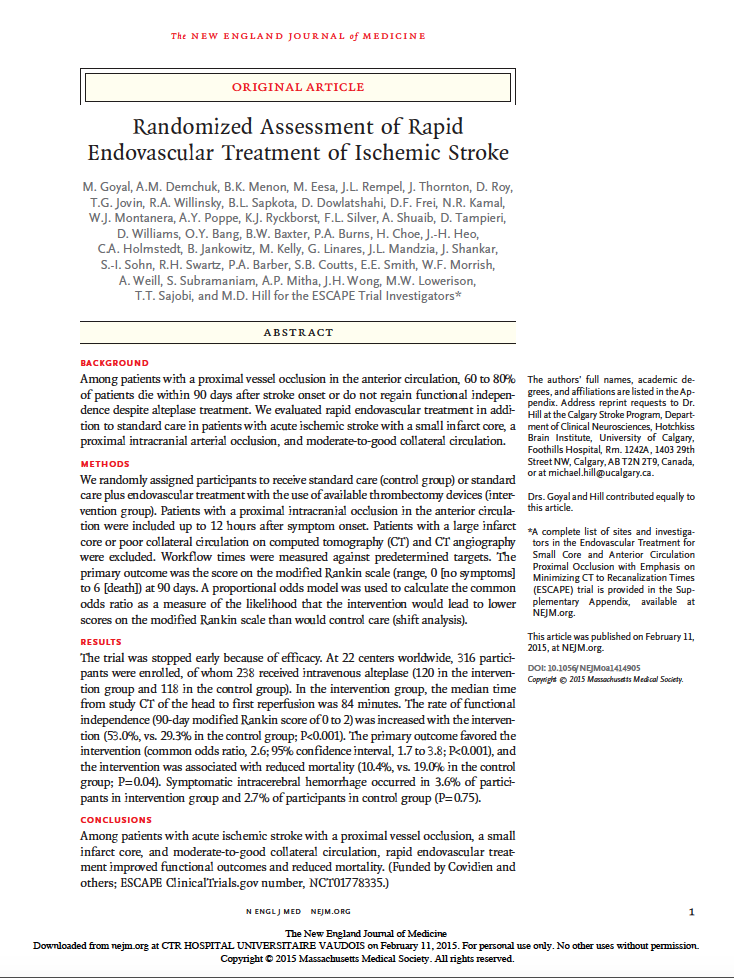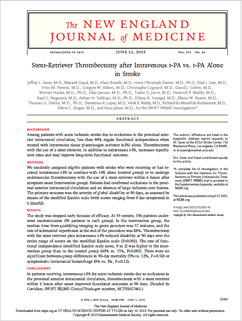Does Your Team Feel Unseen? Close the Leadership Disconnect with 2-Way Communication
Editor's Note: In July 2025, EMS1 and Fitch & Associates released their annual EMS trend survey, What Paramedics Want, proudly sponsored by Pulsara....
2 min read
 Rob Dickson, MD
:
Mar 06, 2015
Rob Dickson, MD
:
Mar 06, 2015

Pulsara recently attended and exhibited at the American Heart Association's annual International Stroke Conference. In addition to Pulsara's poster presentation, several other innovative research studies were presented which promise great strides for the future of stroke care. The successes of the various therapies outlined below, coupled with implementation of the Pulsara solution, hold great promise for significantly improving stroke outcomes.

The ESCAPE Trial (Endovascular treatment for Small Core and Anterior circulation Proximal occlusion with Emphasis on minimizing CT to recanalization times) was a randomized controlled trial (RCT) that included 316 patients who were assigned to one of two groups: mechanical thrombectomy up to 12 hours after onset of symptoms or care as usual including intravenous tPA (the same number of participants in each group received tPA).
The ESCAPE trial was stopped prematurely due to overwhelmingly positive results. Perhaps the most exciting outcome was a significant increase in the rate of functional independence in the intervention group compared to the control group (53.0% vs. 29.3% respectively, p<0.001). The number needed to treat (NNT) for this result to give one additional person functional independence was four. The ESCAPE study also indicated reduced mortality rates for the treatment group (10.4%) compared with the control group (19%, p=0.04).
The facilities that participated in this trial had as their goal a CT to reperfusion time of < 90 minutes. The authors concluded that rapid endovascular therapy improves both functional outcome and mortality rates. Because Pulsara has seen a 156% improvement in D2N times < 60 minutes, introducing Pulsara's Stop Stroke application along with this therapy would be instrumental in meeting time goals and in improving outcomes for stroke patients.

The EXTEND-IA trial (Extending the time for Thrombolysis in Emergency Neurological Deficits with Intra-Arterial therapy) was an RCT with 70 patients who met the following criteria: acute ischemic stroke (AIS) onset less than 4.5 hours, received 0.9mg of alteplase per kilogram of body weight, and had indication by CT of large vessel occlusion. The study group underwent endovascular thrombectomy with the Solitaire™ FR stent receiver in addition to alteplase, the control group received only alteplase.
This trial was also stopped early due to impressive efficacy. EXTEND-IA saw functional outcome of improvement in disability (defined as modified Rankin score (mRS) of 0-2) in 71% of patients in the study group compared with 40% in the tPA-only group (p=0.01). The Pulsara platform together with this therapy will improve case times, thereby further improving functional outcomes.

SWIFT PRIME (Solitaire™ With the Intention for Thrombectomy as PRIMary treatment for acute ischemic strokE) was an RCT with 196 patients who received tPA for AIS less than 4.5 hours from onset and met criteria for NIHSS between 8-29 and had CT evidence of large vessel occlusion. The intervention group was treated with a Solitaire™ FR stent retriever, the control group with usual treatment procedures.
The SWIFT PRIME trial was stopped early due to efficacy and saw an improved neurologic outcome with a 90-day mRS of 0-2 in 60.2% of the intervention group compared to 35.5% (p=0.0008) in the control group. These results translate to some extremely powerful effects, specifically:
The Swift Prime study had as its targets, CT to groin puncture time of ≤ 70 minutes (optimal) and ≤ 90 minutes as the mandatory target. These numbers should be goal points for all facilities in order to most effectively reduce mortality and morbidity. Pulsara's Stop Stroke app has been shown to reduce D2N times by 28%. Just imagine what that could do for your times!
And speaking of you, what is your facility's current plan for meeting target time goals? How does your team coordinate care with regards to:

Editor's Note: In July 2025, EMS1 and Fitch & Associates released their annual EMS trend survey, What Paramedics Want, proudly sponsored by Pulsara....
![[PRESS RELEASE] Published Research Finds Up to 31% Faster STEMI Treatment Times in Rural Hospital Setting with Pulsara](https://www.pulsara.com/hubfs/_1_website-page-blog-assets/pulsara-hosp-teams-assign-cardio-stemi-rn-1200x701.jpg)
Published research shows how using Pulsara, alongside standardized field activation and a focus on stakeholder relationships, improves STEMI care and...

Editor's Note: In July 2025, EMS1 and Fitch & Associates released their annual EMS trend survey, What Paramedics Want, proudly sponsored by Pulsara....